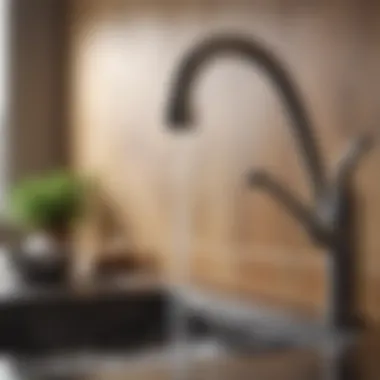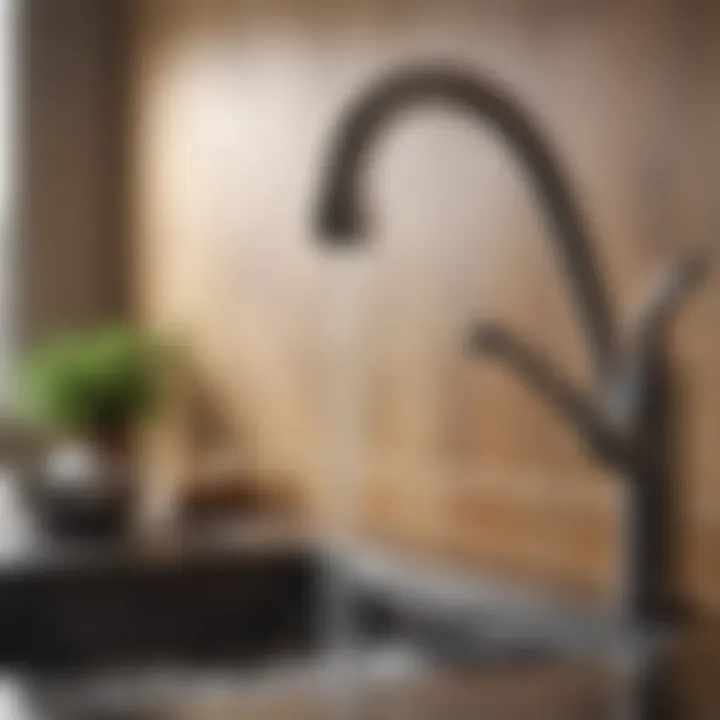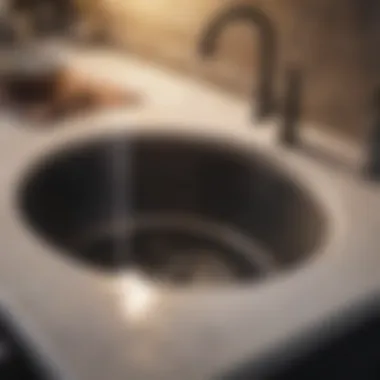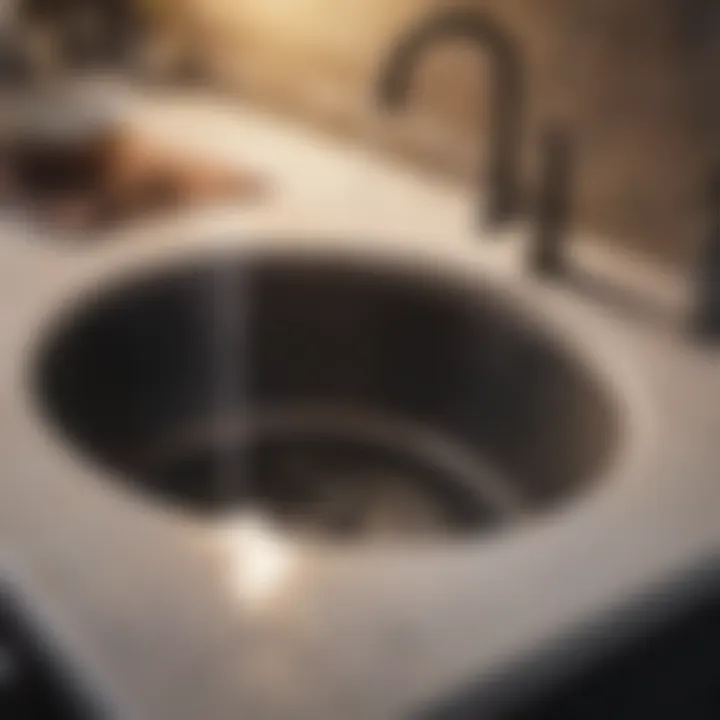Effective Ways to Solve a Clogged Kitchen Sink Easily and Efficiently


The common household annoyance of a clogged kitchen sink can disrupt daily routines and create a messy situation. It is crucial to address this issue promptly to restore functionality and avoid potential damages. From basic home remedies to seeking professional assistance, there are several effective strategies available to tackle this problem. This article aims to delve into a variety of solutions, providing clear instructions and tips for unclogging your kitchen sink with efficiency.
DIY Methods for Unclogging a Kitchen Sink
When faced with a clogged kitchen sink, a DIY approach can often be a cost-effective and practical solution. One common method is using a mixture of baking soda and vinegar to break down clogs and clear the drain. Additionally, utilizing a plunger specifically designed for sinks can help dislodge debris and restore proper water flow. Regular maintenance practices such as using a drain strainer to prevent large particles from entering the pipes can also aid in avoiding blockages.
Professional Interventions for Stubborn Clogs
For persistent or complex clogs, seeking professional help may be necessary. Experienced plumbers have specialized tools such as drain snakes and hydro-jetters that can effectively remove tough obstructions deep within the pipes. Professional intervention ensures a thorough unclogging process, addressing underlying issues to prevent future blockages. By entrusting the task to experts, you can achieve long-term solutions and peace of mind regarding your kitchen sink's drainage system.
Preventative Measures for Maintaining a Clear Drain
To avoid recurrent clogs in your kitchen sink, implementing preventive measures is essential. Being mindful of what goes down the drain, refraining from disposing of grease, coffee grounds, and large food particles can significantly reduce the risk of blockages. Regularly flushing the drain with hot water and vinegar can help prevent buildup and maintain optimal drainage. Embracing these preventive practices can prolong the efficiency of your kitchen sink and minimize the need for frequent unclogging procedures.
Conclusion
Understanding the Issue
In the realm of household inconveniences, a clogged kitchen sink stands as a formidable foe, disrupting daily routines and causing frustration. The significance of understanding the issue lies in its ubiquity and potential complexity. By comprehending the intricacies of sink blockages, individuals can apply targeted solutions, thereby restoring functionality with precision. Delving into the minutiae of blockages offers insights into maintenance practices and augments one's ability to address future occurrences effectively.
Identifying the Blockage
Locating the point of obstruction
A fundamental aspect of the clogging saga is pinpointing the exact location of the obstruction within the sink's intricate plumbing system. Through this process, individuals can strategically approach the blockage, whether near the drain entrance or further down the pipeline. The method's utility manifests in its ability to direct interventions accurately, saving time and effort in the unclogging endeavor. While straightforward, locating the point of obstruction demands patience and attentiveness, distinguishing itself as a reliable tool in the battle against sink clogs.
Determining the cause of the clog
Unearthing the underlying cause of a sink clog is paramount to devising effective remedial measures. By identifying if the obstruction stems from food remnants, grease buildup, or foreign objects, individuals can tailor their unclogging strategies accordingly. This analytical step not only resolves the immediate issue but also informs preventive practices to mitigate future clogs. The nuanced approach to determining the cause of the clog enriches one's problem-solving repertoire, elevating the efficacy of sink maintenance routines.
Assessing the Severity
Evaluating the extent of the blockage


Assessing the severity of a clog involves gauging the depth and density of the obstruction impeding the sink's drainage flow. Understanding the extent of blockage aids in selecting appropriate measures, be it mild interventions for superficial clogs or robust tactics for entrenched blockages. This step's value lies in its ability to prevent exacerbation of the issue through informed decision-making, accentuating the importance of thorough assessment in the unclogging process.
Considering potential complications
Anticipating potential complications that may arise during unclogging efforts fortifies one's preparedness in tackling unforeseen hurdles. By envisioning scenarios such as pipe damage or stubborn obstructions, individuals can preemptively plan for contingencies, ensuring a smoother resolution process. Acknowledging the possibility of complications instills resilience and adaptability, qualities vital in navigating the complexities of sink maintenance.
DIY Remedies
DIY Remedies play a vital role in the context of dealing with a clogged kitchen sink. In this article, DIY Remedies are emphasized for their cost-effectiveness and accessibility. By employing simple household items and techniques, individuals facing a clogged sink can attempt to resolve the issue independently before resorting to professional assistance. The primary focus of this section is to empower readers with practical solutions that they can implement using readily available resources. DIY Remedies not only offer a sense of achievement but also foster a proactive approach towards resolving common household challenges.
Hot Water Flushing
Pouring hot water down the drain
Pouring hot water down the drain is a fundamental yet effective method in addressing the issue of a clogged kitchen sink. The act of pouring hot water serves to dislodge grease, soap scum, and other debris that may be obstructing the drainage system. This technique is particularly beneficial as it is a simple and non-invasive way to attempt to clear minor clogs without the need for specialized tools. However, it is essential to note that while hot water flushing can be successful in some cases, it may not be sufficient for more severe blockages or obstructions caused by solid materials.
Benefits and limitations of this method
The benefits of pouring hot water down the drain lie in its ease of execution and minimal requirement for additional resources. This method is environmentally friendly as it avoids the use of harsh chemicals that may be present in commercial drain cleaners. Additionally, hot water flushing can help prevent future clogs by liquefying greasy residues that could potentially accumulate over time. On the other hand, the limitations of this method include its effectiveness being limited to certain types of clogs and its inability to target solid obstructions. For complex blockages, alternative approaches may be necessary to achieve a satisfactory outcome.
Baking Soda and Vinegar
Creating a natural cleaning solution
The combination of baking soda and vinegar offers a natural and non-toxic solution for cleaning and unclogging kitchen sinks. By mixing these two household ingredients, a foaming reaction occurs that can help break down organic materials, sanitize the drain, and eliminate foul odors. This method is popular among individuals seeking environmentally friendly alternatives to chemical-based cleaners.
Application and effectiveness
When applied correctly, baking soda and vinegar can effectively dislodge debris and neutralize odors within the drain. The bubbling action produced by the reaction helps to agitate buildup, making it easier to flush out trapped particles. While this method is generally safe for most plumbing systems, it may not be suitable for certain materials like marble or granite sinks. Moreover, its effectiveness may vary depending on the nature and severity of the clog, with tougher blockages requiring more robust interventions.
Plunging the Drain
Using a plunger to dislodge the blockage


Using a plunger is a manual method to remove blockages by creating pressure and suction within the pipe. This action can help loosen and dislodge debris causing the obstruction, allowing water to flow freely again. Plunging is an effective technique for dealing with common sink clogs caused by organic matter or mild sediment buildup. However, its success may be limited in cases where the blockage is due to more solid or compacted materials.
Techniques for effective plunging
To effectively plunge a drain, ensure a tight seal between the plunger and the drain opening to maximize suction. Apply firm and consistent pressure while maintaining the seal to create the necessary force for dislodging the blockage. Additionally, for double-bowl sinks, seal off one drain while plunging the other to enhance the effectiveness of the process. Practicing proper plunging techniques and being patient during the process can significantly improve its outcomes while minimizing potential splashback or mess.
Specialized Tools
Specialized tools play a crucial role in effectively addressing a clogged kitchen sink. With their unique capabilities, these tools can tackle stubborn blockages that DIY methods might struggle to resolve. By understanding the specific elements, benefits, and considerations of specialized tools, you equip yourself with the necessary arsenal to combat even the toughest clogs.
Sink Auger
Description and Purpose of a Sink Auger
The sink auger, also known as a plumbing snake, serves a vital role in removing blockages deep within the pipes. Its flexibility and length allow it to navigate through the twists and turns of the plumbing system, reaching clogs that are out of reach for other tools. This makes it an indispensable choice for complex clogs that require a more targeted approach. The unique feature of a sink auger lies in its ability to physically break apart clogs by puncturing through debris, providing a direct and effective solution to clearing the blockage. While its manual operation can be labor-intensive, the sink auger's precision and power make it a valuable asset in this article's repertoire of specialized tools.
Step-by-Step Guide for Using the Tool
Using a sink auger requires a systematic approach to ensure optimal results. Begin by inserting the auger into the drain until you feel resistance, signaling the presence of the clog. Slowly crank the handle, allowing the auger to penetrate the blockage gradually. Continue this process, rotating and pushing the auger further until the blockage loosens and clears. Retrieve any debris that emerges from the drain, and flush the line with water to confirm complete removal. While the manual nature of a sink auger demands physical effort, its effectiveness in dislodging persistent clogs makes it a preferred choice for handling deep-seated sink blockages.
Chemical Drain Cleaners
Understanding the Use of Chemical Cleaners
Chemical drain cleaners offer a potent solution to dissolve organic matter causing clogs in kitchen sinks. Their fast-acting formula breaks down grease, hair, and soap scum, restoring optimal water flow. The key characteristic of chemical cleaners lies in their ability to penetrate and dissolve stubborn clogs quickly, making them a popular choice for addressing immediate drainage issues. However, their aggressive nature can damage pipes over time, necessitating cautious use to prevent long-term harm to the plumbing system. While effective in clearing tough blockages, chemical cleaners should be employed judiciously to mitigate potential risks to the drainage infrastructure.
Safety Precautions and Considerations
When using chemical drain cleaners, it is essential to follow safety protocols to safeguard yourself and the plumbing system. Wear protective gear such as gloves and goggles to prevent skin and eye irritation from the chemicals. Avoid mixing different types of cleaners, as this can trigger harmful reactions. Additionally, ensure adequate ventilation while using chemical products to minimize inhalation risks. While chemical drain cleaners deliver swift results, their corrosive properties mandate careful handling and storage to prevent accidents and protect the integrity of your drainage system.
Seeking Professional Help
Are you facing a persistent and stubborn clog in your kitchen sink that DIY remedies cannot seem to address effectively? Seeking professional help can be a crucial step in resolving complex drainage issues. Plumbers bring a wealth of expertise and specialized tools to tackle even the most challenging blockages. In the context of this article, professional assistance serves as a key component in the spectrum of solutions for dealing with a clogged kitchen sink. Whether it's a build-up of grease, food particles, or mineral deposits causing the blockage, a plumber's intervention can provide a lasting fix.


Plumber Assistance
Knowing when to Call a Professional Plumber
Recognizing the signs that indicate the need for professional plumbing assistance is vital for addressing clogged sink issues effectively. Factors such as recurring clogs, slow drainage, or gurgling sounds in the pipes are clear indicators that DIY methods may not suffice. Calling a professional plumber ensures a thorough inspection of the plumbing system, identifying underlying issues that DIY solutions may overlook. The expertise of a plumber lies in their ability to diagnose the root cause of the clog and implement targeted solutions, saving homeowners time and frustration.
Cost Implications and Benefits
Understanding the cost implications and benefits of hiring a professional plumber is essential for making informed decisions. While professional plumbing services come at a cost, the long-term benefits often outweigh the initial expense. Plumbers have access to advanced tools and technologies that can effectively clear tough clogs without causing damage to the pipes. Moreover, timely intervention by a plumber can prevent minor issues from escalating into major plumbing emergencies, saving homeowners from costly repairs. By weighing the advantages of professional expertise and efficient solutions against the cost of service, homeowners can make a well-informed choice that prioritizes long-term drainage effectiveness.
Maintenance Tips
Maintaining your kitchen sink is paramount to ensure proper functionality and prevent frequent clogs. By following a few key maintenance tips, you can keep your sink running smoothly and avoid unnecessary hassles. Regular maintenance not only saves you time and effort in the long run but also prolongs the lifespan of your drainage system.
Preventive Measures
Practical steps to avoid future clogs
Implementing practical preventive measures is crucial in maintaining a clear and efficient kitchen sink drainage system. Simple tasks such as using a drain strainer to catch debris, refraining from pouring grease down the drain, and consistently running hot water can significantly reduce the risk of blockages. These proactive steps contribute to the overall health of your sink and prevent the inconvenience of dealing with constant clogs.
Key to these measures is the consistency in applying them, ensuring that they become part of your routine. By adopting these habits, you can prevent major blockages and potential plumbing issues. While these actions may seem basic, their impact on your kitchen sink's maintenance cannot be underestimated.
Regular maintenance routines
Establishing regular maintenance routines for your kitchen sink is vital in preventing unexpected clogs and maintaining optimal functionality. Scheduled inspections, occasional deep cleaning using natural solutions like baking soda and vinegar, and checking for leaks around the sink are essential tasks. By incorporating these routines into your household maintenance schedule, you not only enhance the longevity of your sink but also save on repair costs in the future.
Consistency is key when it comes to regular maintenance. By taking these preventive measures seriously and staying proactive, you can enjoy a clog-free kitchen sink and ensure the smooth operation of your drainage system.
Care for Drainage System
Best practices for maintaining kitchen drains
Adhering to best practices for maintaining your kitchen drains is fundamental in preserving their functionality and longevity. Avoiding disposing of food scraps, coffee grounds, and oil down the sink, and periodically flushing the drain with hot water can prevent the buildup of debris and grease, thus reducing the risk of blockages.
The key characteristic of adopting these best practices is the prevention of unnecessary clogs. By following these guidelines, you mitigate the chances of encountering a clogged kitchen sink and maintain an efficient drainage system.
Products to aid in upkeep
Using specialized products to aid in the upkeep of your kitchen sink is an additional measure you can take to promote its health. Drain cleaning solutions and enzyme-based cleaners can help break down organic matter and keep your pipes clear. It is essential to choose products specifically designed for kitchen drains to ensure their effectiveness and avoid any damage to the plumbing.
The unique feature of these products lies in their ability to target and eliminate stubborn clogs, contributing to the overall maintenance of your drainage system. When used appropriately and in conjunction with other maintenance practices, these products can be a valuable asset in keeping your kitchen sink in optimal condition.



